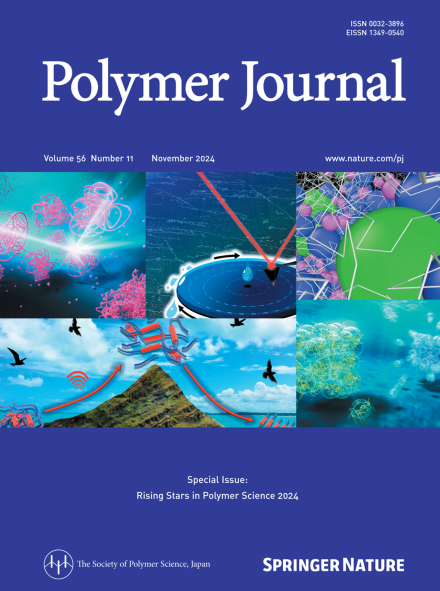环硅氧烷型液晶环氧热固性材料有序网状聚合物结构对其断裂韧性和导热性能的影响
IF 2.7
4区 化学
Q3 POLYMER SCIENCE
引用次数: 0
摘要
使用两种芳香胺固化剂制备了具有环硅氧烷结构的液晶环氧热固性塑料:4,4'- 二氨基二苯基乙烷 (DDE) 和对苯二胺 (p-PDA)。通过偏振光学显微镜、X 射线衍射分析和透射电子显微镜对网状链结构进行了详细研究。所获得的环氧热固性塑料形成了低密度畴结构,DDE 系统的低密度畴结构约为 5 μm,p-PDA 系统的低密度畴结构约为 2-5 μm。特别是,p-PDA 系统中的低浓结构域由高度排列的胶相组成。与 DDE 体系相比,p-PDA 体系的模量最高,这是因为其具有平滑有序网络链的堆积结构。此外,还研究了网络聚合物结构对断裂韧性的影响。随着取向结构的形成,观察到了较高的断裂韧性,p-PDA 系统的断裂韧性达到了 1.15 kJ/m2 的最大值。在环氧树脂骨架中引入柔性硅氧烷结构略微抑制了热导率的增加。然而,由于高度定向结构,p-PDA 系统的热导率略高(0.28 W/(m K))。制备了具有环状硅氧烷结构的液晶环氧热固性塑料。所获得的环氧热固性塑料形成了液晶畴结构,并由于共晶有序网络链的堆积结构而表现出较高的模量和断裂韧性。柔性硅氧烷结构的引入略微抑制了热导率的增加,而高取向结构则带来了 0.28 W/(m K) 的高热导率值。本文章由计算机程序翻译,如有差异,请以英文原文为准。

Effect of the ordered network polymer structure of cyclic-siloxane-type liquid crystalline epoxy thermosets on their fracture toughness and thermal conductivity
Liquid crystalline (LC) epoxy thermosets with a cyclic siloxane structure were prepared using two types of aromatic amine curing agents: 4,4’-diaminodiphenylethane (DDE) and p-phenylenediamine (p-PDA). The networked chain structure was investigated in detail via polarized optical microscopy, X-ray diffraction analysis, and transmission electron microscopy. The obtained epoxy thermosets formed an LC domain structure that was approximately 5 μm for the DDE system and 2–5 μm for the p-PDA system. In particular, the LC domains in the p-PDA system were composed of a highly aligned smectic phase. Compared with the DDE system, the p-PDA system had the highest modulus due to the packing structure of the smectic ordered network chains. The effect of the networked polymer structure on the fracture toughness was also investigated. High fracture toughness was observed with the formation of the oriented structures, and a maximum value of 1.15 kJ/m2 was attained for the p-PDA system. The introduction of a flexible siloxane structure in the epoxy backbone slightly suppressed the increase in the thermal conductivity. However, the thermal conductivity of the p-PDA system was slightly greater (0.28 W/(m K)) because of the highly oriented structure. Liquid crystalline (LC) epoxy thermosets with a cyclic siloxane structure were prepared. The obtained epoxy thermosets formed an LC domain structure and exhibited a high modulus and fracture toughness as a result of the packing structure of the smectic ordered network chains. The introduction of a flexible siloxane structure slightly suppressed the increase in thermal conductivity, and the highly oriented structure resulted in a high thermal conductivity value of 0.28 W/(m K).
求助全文
通过发布文献求助,成功后即可免费获取论文全文。
去求助
来源期刊

Polymer Journal
化学-高分子科学
CiteScore
5.60
自引率
7.10%
发文量
131
审稿时长
2.5 months
期刊介绍:
Polymer Journal promotes research from all aspects of polymer science from anywhere in the world and aims to provide an integrated platform for scientific communication that assists the advancement of polymer science and related fields. The journal publishes Original Articles, Notes, Short Communications and Reviews.
Subject areas and topics of particular interest within the journal''s scope include, but are not limited to, those listed below:
Polymer synthesis and reactions
Polymer structures
Physical properties of polymers
Polymer surface and interfaces
Functional polymers
Supramolecular polymers
Self-assembled materials
Biopolymers and bio-related polymer materials
Polymer engineering.
 求助内容:
求助内容: 应助结果提醒方式:
应助结果提醒方式:


